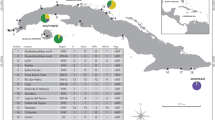Abstract.
Allelic variation at eight nuclear-encoded microsatellites was assayed among 967 red drum (Sciaenops ocellatus) sampled from four consecutive cohorts at seven geographic localities (=28 samples total) in the northern Gulf of Mexico (Gulf). Number of alleles per microsatellite ranged from 6 to 21; average direct-count heterozygosity values per sample (±SE) ranged from 0.560±0.018 to 0.903±0.009. Tests of Hardy-Weinberg equilibrium revealed significant departures from expected genotype proportions at one microsatellite, which was omitted from further analysis. Tests of genotypic equilibrium indicated that genotypes between pairs of microsatellites were randomly associated. Homogeneity tests of allele distributions across cohorts within localities were non-significant following correction for multiple tests executed simultaneously, and results from molecular analysis of variance indicated that the genetic variance component attributable to variation among cohorts did not differ significantly from zero. Homogeneity tests of allele distributions among localities (cohorts pooled) revealed significant differences both before and after correction for multiple tests. Neighbor-joining clustering of a pairwise matrix of θ values (an unbiased estimator of F ST), spatial autocorrelations, and regression analysis revealed a pattern of isolation by distance, where genetic divergence among geographic samples increases with geographic distance between sample localities. The pattern and degree of temporal and spatial divergence in the nuclear-encoded microsatellites paralleled almost exactly those of mitochondrial (mt) DNA, as determined in a prior study. Stability of both microsatellite and mtDNA allele distributions within localities indicates that the small but significant genetic divergence among geographic samples represents true signal and that overlapping populations of red drum in the northern Gulf may be influenced by independent population dynamics. The degree of genetic divergence in microsatellites and mtDNA is virtually identical, indicating that genetic effective size of microsatellites and mtDNA in red drum are the same. This, in turn, suggests either that gene flow in red drum in the northern Gulf could be biased sexually or that red drum populations may not be in equilibrium between genetic drift and migration. If a sexual bias exists, the observation that divergence in mtDNA is considerably less than 4 times that of microsatellites could suggest female-mediated dispersal and/or male philopatry. The observed isolation-by-distance effect indicates a practical limit to dispersal. Approximate estimates of geographic neighborhood size suggest the limit is in the range 700–900 km. Although the genetic studies of red drum indicate significant genetic divergence across the northern Gulf, the genetic differences do not delimit specific populations or stocks with fixed geographic boundaries.
Similar content being viewed by others
Author information
Authors and Affiliations
Additional information
Electronic Publication
Rights and permissions
About this article
Cite this article
Gold, .J., Turner, .T. Population structure of red drum (Sciaenops ocellatus) in the northern Gulf of Mexico, as inferred from variation in nuclear-encoded microsatellites. Marine Biology 140, 249–265 (2002). https://doi.org/10.1007/s002270100692
Received:
Accepted:
Issue Date:
DOI: https://doi.org/10.1007/s002270100692




